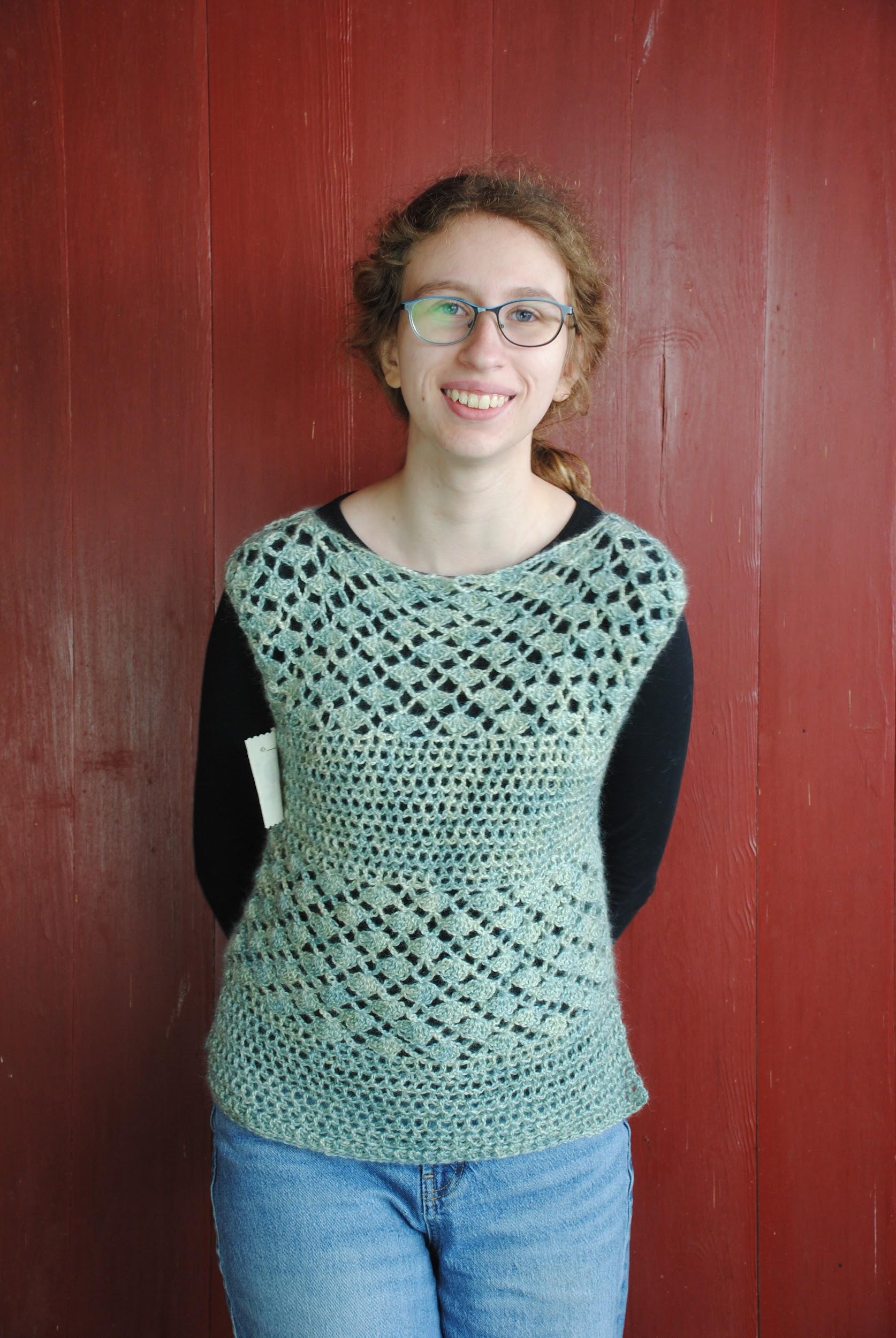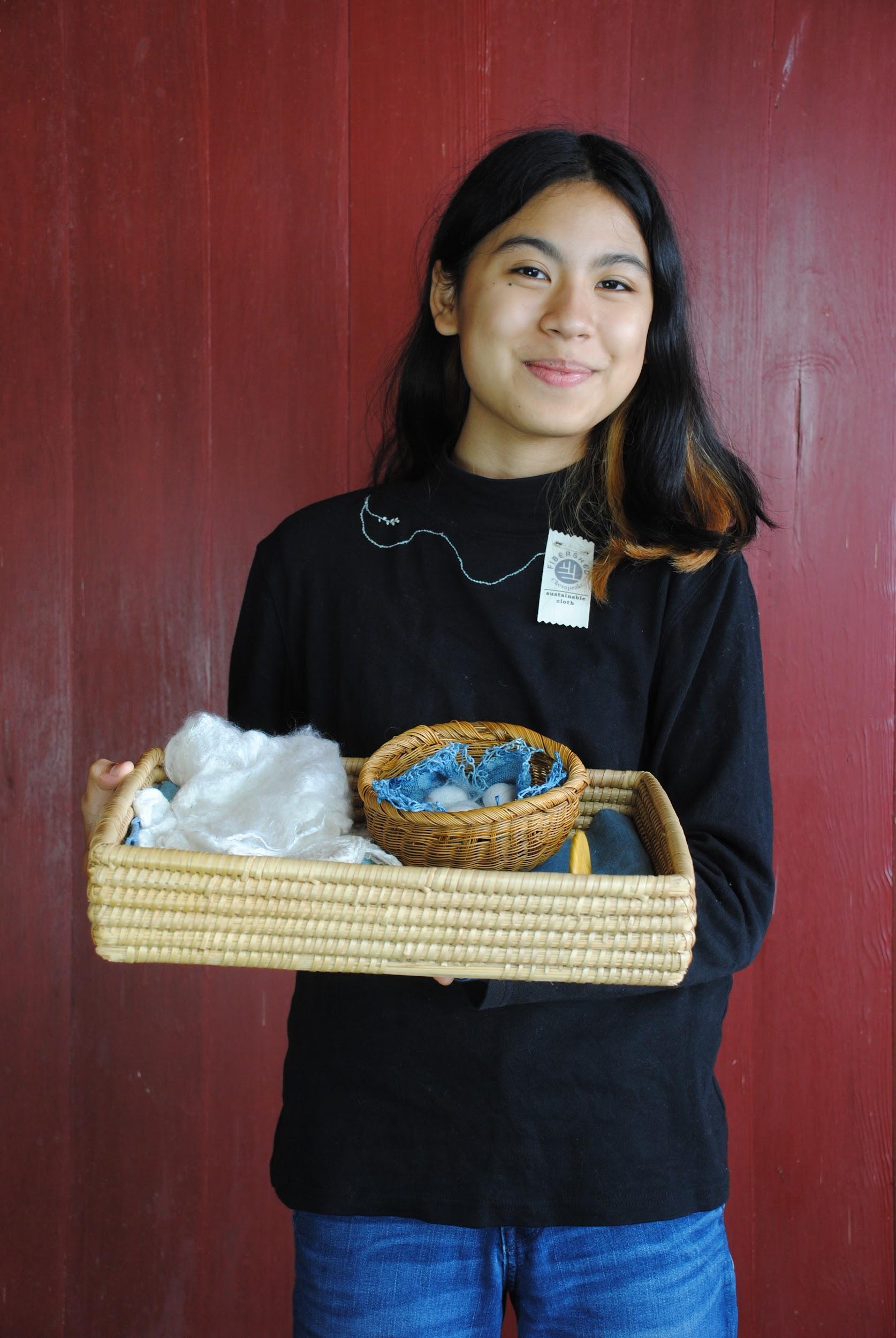
8 minute read
Kerstin Zurbrigg
The Youth Indigo Partnership
The projects from the youth group addressed the questions: what is sustainable, what is regenerative and what are the impacts of our choices? Their individual and collective approaches to answering the questions formed an intersection of exploratory, challenge streams in conversation, with a focus on material sourcing and farming. They worked together to create a community- shared, sustainable dye garden, which was the guiding inspiration for their collective and individual approaches.
Advertisement
In May, two large garden beds (roughly 5’ x 8’) were created using no-till methods and through adapting restorative gestures to the earth in composting and mulching practices. Pollination was encouraged through sustaining a diversity of plants in the shared environment. These investigations of regenerative agriculture principles became a primary endeavor in the shared garden. The seeds were 7th generation indigo (Polygonum tinctorium/Persicaria tinctoria) seeds, open-pollinated, and originally sourced from Putnam Hill Nursery, Rowland Ricketts and Craig Wilkinson. Seeds were planted tightly to dissuade weeds and to minimize the need for watering through the height of the summer.
After the first harvest in early August, Sylvia and Ava used a fresh-leaf ice bath extraction method to dye wool yarn and roving sourced from local farms. In late July, leaves were frozen and saved for use when the projects would be further along. This method of preservation and of color release was brought to us all courtesy of local spinner and dyer Kathie Bryant (and, for the flexibility of this method, and extension of time in utilizing a fresh leaf process, we are truly grateful). Ella and Maya’s yarns were dyed in the richly pigmented waters from the process of freezing fresh indigo leaves. The garden continued to thrive and the indigo plants grew bountifully well into the month of September when successive harvests were gathered. The vibrancy of the plants had much to do with the connections, caretaking and restorative practices so beautifully given to the space of the garden. In the late fall, seeds from these plants were gathered and dried with the hope that they will be planted in future community-shared gardens.

Streams of Indigo: Misty Shoots
Stream: Embracing
Yearling mohair yarn from Flying Goat Farm Sylvia was inspired to work with shades of light blues. She had a specific color in mind for her project and then based her sweater around what she thought would match that color. Although inspired by other sweaters and patterns, the pattern for Misty Shoots was completely of her own making. She started with a stitch that she knew she wanted to include and then worked from there to create the rest of the sweater. Sylvia not only learned about how to create a pattern but she also learned about the dying process of working from fresh leaf indigo and extracting color with ice.
The Youth Indigo Partnership
The team brought their projects together by creating their own shared indigo garden. Over the course of the year they grew two beds of indigo from seed, and worked together to process it. They explored the possibilities of fresh indigo through Streams of Indigo, four projects that explore the colors of indigo through their own lens.

Streams of Indigo: Blooming Breeze
Stream: Embracing/Re-emvisioning
Ella decided to reuse one of her old old projects and repurpose the yarn into a project that she would actually finish and wear. Blooming Breeze is made from yarn which she had previously cleaned, spun, and knit and thenunraveled as she worked from the old piece to the new piece. After the sweater was knit she dyed it with fresh indigo leaves in an ice bath. While working on the project she learned about the process of growing and dying with indigo.
The Youth Indigo Partnership
The team brought their projects together by creating their own shared indigo garden. Over the course of the year they grew two beds of indigo from seed, and worked together to process it. They explored the possibilities of fresh indigo through Streams of Indigo, four projects that explore the colors of indigo through their own lens.

Streams of Indigo: Harvest Sky
Stream: Embracing
Finn sheep wool purchased from Solitude Wool up-cycled yarn spun by Kerstin Zurbrigg from a Coopworth sheep called Einkorn from Arbormeadow Farm in Virginia.
Ava handspun and dyed the local Finn wool that she purchase. She was inspired to explore texture and color. She wanted to work with different gauges of yarn and experimented with needle size as a way to increase and decrease while working on Harvest Sky. Through this process she learned about the relationship of the yarn and the needle and how it affects the drape and quality of the knitting. Ava used trial and error to make a sweater without apattern and used her senses and gut feelings to decide what to do in the pattern. She also was not afraid to take out her knitting when she did not like the way it looked.
The Youth Indigo Partnership
The team brought their projects together by creating their own shared indigo garden. Over the course of the year they grew two beds of indigo from seed, and worked together to process it. They explored the possibilities of fresh indigo through Streams of Indigo, four projects that explore the colors of indigo through their own lens.

Streams of Indigo: Frozen Roots
Stream: Embracing/Re-envisoning Silkworm eggs raised from a sericulture institute in Padua, Italy.
Frozen Roots was inspired by re-envisioning old things and by nature. Maya wanted to turn something that was unwanted and unused and make it something new, creative, and elegant. She raised the silkworms whose silk she used for embroidery. In the process she learned about the lifecycle of the silkworm from egg to cocoon to moth, and how to process the silk from the cocoons. Maya worked with a spinner, Kerstin Zurbrigg, to help her to develop an embroidery thread for her work. Once the embroidery thread was ready she dyed it with indigo. She learned about the processes of developing silk from cocoons with Reneta Maile-Moskowitz and then applied thisto her project.
The Youth Indigo Partnership
The team brought their projects together by creating their own shared indigo garden. Over the course of the year they grew two beds of indigo from seed, and worked together to process it. They explored the possibilities of fresh indigo through Streams of Indigo, four projects that explore the colors of indigo through their own lens.

Stream: Embracing
Finn sheep fleece from Honeysuckle Farm, MD Angora goat locks from Peavine Hollow Farm, VA Blue Faced Leicester x California Red fleece (Lexie), Sweet Gum Farm, VA, scoured then combed with Louet mini combs Finn sheep wool (lamb, Sanna)/angora locks blended and milled to roving at Gurdy Run Woolen Mill, PA; Second Finn fleece milled to roving at Central Virginia Fiber Mill (re-processed with Louet mini combs).
Yarns were spun on a Schacht Matchless wheel Indigo dyes were processed from garden grown Japanese Indigo, Polygonum tinctorium, in Silver Spring, MD (original seed source: Putnum Hill Nursery). Small skein of homespun Finn wool yarn dyed with an exhausted date reduction indigo vat using Stoney Creek Colors indigo pigment Black walnuts from our garden and nearby trees in Silver Spring, MD I was inspired to create an organically formed knitting pattern, one which is informed by the passage of time, the shape of one’s own body and loosely based on the design of a favorite, thrifted cowl sweater. My intentwas to explore the color blue, the presence of pigment in woad and indigo at different times of the year, to work with color derived from local trees and to continue to find ways to bring vitality to the garden. The projectwas a collaboration with the plants around me, to create a painterly experience of knitting and to develop a fabric which was woven from my immediate landscape.
The sweater was knit over the course of the year, the wool was spun and dyed throughout the seasons. The sweater is both a journal of working with the element of time and seasons in the garden and a journal of my own mark making. After each period of knitting I allowed a small length of the indigo-dyed working yarn to come to sit in a bowl of black walnut ink. The ink marked the intersection of my pauses and starts. I came to see these marks both as symbolic tree rings and as the confluence of two plant streams. The sweater became very much a process of meditation and connection, as I consciously chose to knit without other distractions, mostly in the early morning. The project provided an opportunity to observe the lightfastness of fresh leaf extractions on wool with the notion that should the colors fade, the whole sweater could be re-dipped in a summer indigo harvest to revive the color. In the end, through new processes and relationships, it appears the fresh leaf pigment expressions become less transitory.
Kerstin Zurbrigg
Kerstin Zurbrigg is an artist, teacher, writer with a background in fine arts and natural history. Kerstin has lived in the DC area for 17 years, homeschooling her three children, exploring multidisciplinary approaches to fiber arts through teaching, spinning yarns from local farms, gardening, working with plant pigments, and exploring healing aspects of our connection to plants and the earth.













